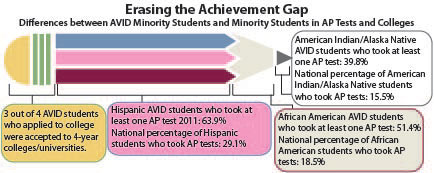
Monday Dec. 3, an AVID representative held two sessions of informative meetings for a team of teachers from each affected school. Each session lasted three hours and included an awareness session, as well as a modeling of instruction strategies that AVID entails.
“We’re still in the planning stages. This is just part of them getting to know us, and us getting to know their program and then helping us decide if we want to get into a partnership with each other,” CPS Assistant Superintendent Jolene Yoakum said. “If I recommend this to be funded, I want to make sure that we have what I would call a critical mass of people that see the value in the program.”
The AVID curriculum focuses on note-taking, studying and problem-solving skills that are useful in college-level courses. The elective class is led by a teacher and college tutors. If approved in the 2012-2013 budget, AVID has an estimated starting cost of $160,000 for curriculum and training, Yoakum said, but the price would rise when hiring more tutors and teachers became necessary.
The go-ahead for the program would come in March, Yoakum said, which would give teachers time to attend training over the summer so that implementation could start in August. Yoakum said each school involved in AVID would have independence in certain aspects of the program, but AVID also standardizes much of its curriculum.
“Buildings will select their own teacher for the AVID program, and they can have choice as to different options for training, and they can have choice about how fast the pace [is] with which they implement it. There’s some things that are loose, and some things that are tight. I call those loose,” Yoakum said. “The tight things, the things they will not have a choice on, is implementing the curriculum and attending the training.”
Last week’s initial training sessions come after visits to three different schools across the Midwest. Yoakum led different teams of teachers, counselors and administrators to each. In Madison, Wis., Yoakum said the team saw the AVID program in action, but also learned strategies to repeat the district’s success in closing the achievement gap. In North Kansas City, Kan., the program was in its second year and less ingrained than in Wichita, Kan., where AVID had been in place for a decade.
“In Wichita … they’d been doing it much longer. It was more student driven. … They had infused that tutoring process, which is inquiry-based, so deeply that the students were asking each other questions to help that person solve their problem, as opposed to the teacher asking the questions,” Yoakum said. “It was more student talk and less teacher talk, which I think is a good thing.”
For RBHS counselor Samuel Martin, this student-driven tutoring session was especially inspiring when he saw students in on-level math at the middle school help a student solve a far more advanced math problem. This format addresses “deficiencies” and points of confusion, Martin said, so that students can then work on facing and surpassing that academic challenge. Martin said this process is very important for students who “haven’t challenged themselves before,” an experience he saw firsthand as a first-generation college student.
“I really just struggled on my own,” Martin said. “A program like this would have [given] me words, would have [given] me a cohort. … Rock Bridge is really good at having challenging courses, but any time you can provide a more structured support system for individuals who aren’t challenging themselves, especially for individuals that haven’t done so in the past, I think that’s a good thing.”
Providing support for the “middle” is part of the district’s efforts to close the achievement gap, Battle High School Principal Kim Presko said in an email interview. At BHS, the program’s tenets “can be an expectation from the beginning rather than trying to change something that has been here for years,” she said. Still, even as a part of the school’s culture from its start, AVID will be just one strategy to eliminate the achievement gap.
“AVID will not be the program that will completely close the achievement gap, but it will help the students in the middle challenge themselves and help our AP and honors classes look more representative of the population of our whole student body,” Presko said.
At RBHS, unlike BHS, the program will be new to the school, but it would fit in well with the existing culture, Principal Mark Maus said. When he visited Wichita, he sat in on two student panels that convinced him that AVID would be successful at RBHS, where teachers already encourage students to do well.
“What a lot of [the students] talked about was the class kind of became like a family, in that it was a support they wouldn’t have had otherwise,” Maus said. “‘No one had told them, ‘Hey, you can do AP work. You can reach this level.’ … This course provides a framework of how to take notes and work through problems and get some of those study skills and some of those soft skills that can help you be successful in those upper level courses.”
By Nomin-Erdene Jagdagdorj
LATEST NEWS
- Bruins Baseball ranks second in the state, April 20
- Stress, anxiety skyrocket as students prepare for upcoming AP tests
- RBHS holds successful night of percussion
- Not even water?
- Solar eclipse to pass through Missouri, April 8
- How CPS is organized: a guide
- City of Columbia to hold school board election April 2
- Youth Election Participants to assist in upcoming municipal election
- City of Columbia hosts first Community Engagement Session for McKinney Building, hopes to gain public insight on the structure’s future
- RBHS Track Team Opener at Battle Gallery




















































































